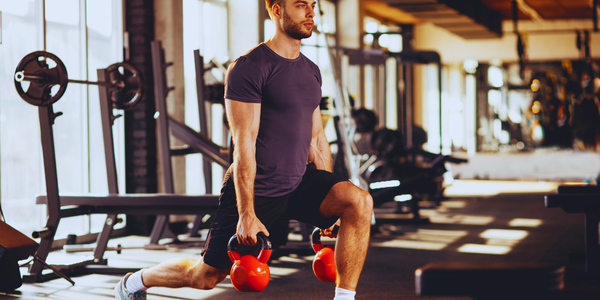Can't Do Squats? These 6 Exercises Give You the Same Benefits
Discover effective squat alternative exercises that build leg strength and muscle without straining your knees. Get the same benefits with these 6 joint-friendly movements

https://www.youtube.com/watch?v=JH_8g8u0eOc
Did you know 68% of fitness fans struggle with squats because of joint pain or limited mobility? If squats are tough for you, don't worry. You can still build lower body strength without the pain.
Squat alternatives are a great way to build muscle and strengthen your legs. These exercises work your muscles just like squats but are easier on your body. They're perfect if you're recovering from an injury or want to mix up your workout.
Each alternative targets important muscles like your quads, glutes, and hamstrings. This ensures you get the full benefit of lower body workouts. Try Bulgarian split squats or floor bridges for a change of pace. They offer the same benefits as squats but in a new way.
Key Takeaways
- Multiple exercises can replace traditional squats effectively
- Leg exercises can target multiple muscle groups simultaneously
- Low-impact alternatives reduce joint strain
- Resistance training can be adapted to individual fitness levels
- Proper form is crucial for preventing injury
Understanding the Importance of Lower Body Training
Lower body strength is key in our daily lives and physical performance. Your hip muscles are not just for looks. They are essential for almost every movement. Bodyweight workouts for the lower body can change how you move and feel.
The Role of Hip Extensors in Daily Life
Hip extensors power many daily tasks. Glute activation is crucial for:
- Climbing stairs
- Picking up objects from the ground
- Standing up from a seated position
- Walking and running efficiently
Why Traditional Squats Might Not Work for Everyone
Not everyone can do traditional squats. Knee-friendly exercises are vital for those with:
- Joint pain
- Limited mobility
- Previous injuries
- Strength discrepancies
Benefits of Alternative Lower Body Exercises
| Exercise | Primary Muscles Targeted | Key Benefits |
|---|---|---|
| Leg Press | Quadriceps, Glutes | Reduced lower back stress |
| Step-Ups | Quads, Hamstrings | Improves balance and coordination |
| Floor Bridges | Glutes, Core | Low-impact glute activation |
Trying different exercises keeps your lower body strong safely. Variety in your workout routine prevents plateaus and keeps your muscles challenged.
Squat Alternative Exercises for Maximum Results
Building strong legs doesn't have to mean only squats. Resistance Training has many ways to strengthen leg muscles. Fitness experts suggest different exercises that work similar muscles but are easier on your joints.
Here are six squat alternatives that boost Glute Activation and leg strength:
- Glute Bridges: Works gluteal muscles with little equipment
- Hip Hinges: Strengthens the back and hamstrings
- Step-Ups: Boosts leg power on one side
- Rear Lunges: Increases stability and muscle use
- Lateral Lunges: Focuses on moving in all directions
- Kettlebell Swings: Increases explosive power in the lower body
| Exercise | Primary Muscles | Recommended Sets/Reps |
|---|---|---|
| Glute Bridges | Glutes, Hamstrings | 2-3 sets, 12-15 reps |
| Hip Hinges | Lower Back, Hamstrings | 2-4 sets, 10-12 reps |
| Step-Ups | Quadriceps, Glutes | 2-4 sets, 10-12 reps per leg |
Each exercise has its own benefits for your legs. Mixing these movements helps avoid getting stuck in a routine and lowers injury chances.
How to Program Your Lower Body Workout
Creating a good lower body workout needs careful planning. This ensures you get the most from resistance training. Your approach to bodyweight exercises and building lower body strength greatly affects muscle growth and fitness.
Building a solid lower body routine means knowing key programming rules. These rules help grow muscles and avoid hitting a wall.
Optimal Sets and Repetitions
For the best lower body strength, follow these tips:
- Do 3-4 sets for each exercise
- Shoot for 10-12 reps in each set
- Rest for 30-45 seconds between sets
- Choose three to four exercises that work well together
Rest and Recovery Guidelines
Rest is key in resistance training. Experts say to give at least 24 hours off after intense lower body workouts. A good weekly plan might be:
- Two days for lower body strength
- One to two days for cardio
- One day for complete rest
Progressive Overload Techniques
To keep pushing your muscles and growing, use progressive overload. This means:
- Slowly add more weight
- Do more reps
- Shorten rest times
- Try harder movements
Sticking to a smart training plan is key to lasting lower body strength.
Conclusion
Fitness journeys are unique, and not everyone can do traditional squats. Knee-friendly exercises are a great solution for those looking to train their legs safely. By trying different leg exercises, you can strengthen your muscles and avoid injuries.
Squat alternatives are a great way to work on your lower body. They fit different fitness levels and help if you have back pain or mobility issues. Exercises like Bulgarian split squats and leg press machines target important muscles without putting too much strain on your back.
Being adaptable and consistent is key to good lower body training. Pay attention to your body and focus on doing exercises right. This way, you can keep challenging yourself and reach your fitness goals safely.
Every fitness journey is special. Don't let physical limits stop you. With patience and the right exercises, you can build strong lower body muscles. It's all about finding the right approach and sticking with it.
FAQ
Why should I look for squat alternatives?
Some people might need squat alternatives because of joint pain or mobility issues. Others might have had injuries or find traditional squats uncomfortable. These alternatives can help engage muscles and build strength without the risk of injury.
Are these exercises as effective as traditional squats?
Yes, exercises like glute bridges and step-ups can target similar muscles. They include quadriceps, hamstrings, and glutes. When done right and with increasing weight, they can be just as effective as squats.
Can I build muscle without doing traditional squats?
Absolutely! You can use lunges, hip hinges, and kettlebell swings to grow muscles. The key is to use proper form, challenge yourself, and train regularly.
How often should I perform these alternative exercises?
You can do these exercises 2-3 times a week. This allows for enough rest and recovery. Your fitness level and goals will help decide how often and how hard to train.
What equipment do I need for these exercises?
Many of these exercises need little to no equipment. Bodyweight squats and glute bridges require none. Others might use dumbbells or resistance bands for more challenge.
Are these exercises suitable for beginners?
Yes, most alternatives can be adjusted for beginners. Start with bodyweight versions and add weights or reps as you get stronger and more confident.
Can these exercises help with knee pain?
Many of these exercises are good for the knees and can help with pain. Glute bridges and hip hinges are less stressful on the knees but still work the lower body well.
How do I know which alternative is best for me?
The best alternative depends on your goals, current fitness, and any limitations. It's wise to talk to a fitness expert or physical therapist. They can help choose the best exercises for you.
Source Links
- New Squat Exercsises as Squat Alternatives | NASM.org
- 6 Lower-body Exercises to Do Instead of Squats
- 5 Squat Alternatives That Don't Use a Barbell | TrainHeroic
- New Squat Exercsises as Squat Alternatives | NASM.org
- Squat Alternatives | Avoid Injury & Build Strength | XMARK
- 5 Effective Squat Alternatives for Lower Body Workouts
- New Squat Exercsises as Squat Alternatives | NASM.org
- 6 Lower-body Exercises to Do Instead of Squats
- New Squat Exercsises as Squat Alternatives | NASM.org
- 6 Lower-body Exercises to Do Instead of Squats
- 5 Effective Squat Alternatives for Lower Body Workouts
- 5 Best Squat Alternatives for Bad Back by Dr. & CSCS
- 24 Best Squat Alternatives For Different Needs
👉 Join the Active Man Community
Get expert tips, workout guides, nutrition hacks, and the latest trends delivered straight to your inbox every week. No spam — just actionable insights to help you live stronger, healthier, and better.





